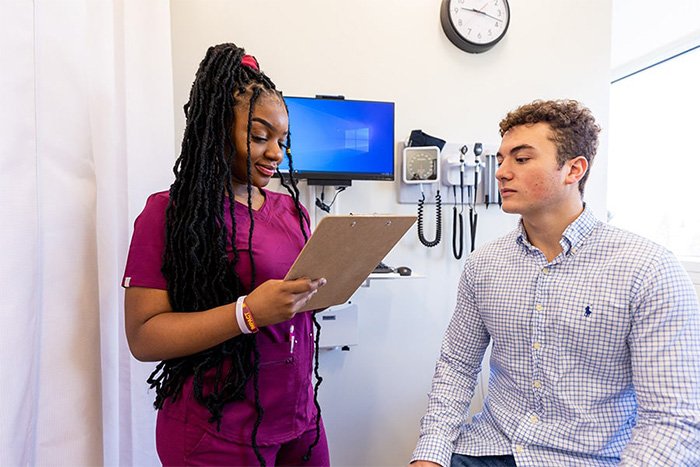RN to BSN Program Mission and Goals



College mission, vision and values
Mission
Through The Herbert H. and Grace A. Dow College of Health Professions, we foster and sustain a culture of excellence through collaborative clinical/professional practice, learner-centered education, leadership, research, and service.
Vision
The Herbert H. and Grace A. Dow College of Health Professions is to be nationally recognized for the development of professionals who contribute to an inclusive, healthy society.
Values
To achieve our mission we adhere to the core values of integrity, respect, compassion, inclusiveness, social responsibility, excellence, and innovation.
RN-to-BSN program mission
The mission of the RN-to-BSN program is to create a culture of excellence that promotes the personal and professional growth of students to become nursing leaders through systems thinking, research, and service.
The RN-to-BSN program recognizes the unique characteristics and needs of our diverse, primarily rural setting, preparing graduates to provide nursing care to individuals, families, groups, communities, and populations in a variety of settings.
Program graduates demonstrate competence in clinical judgment, collaborate as members and leaders of interprofessional healthcare teams, and utilize evidence-based interventions to manage illness; promote, maintain, and restore health across the lifespan.
RN-to-BSN program goals
- Provide graduates with a strong foundation in nursing leadership, evidence-based practice, systems thinking, and population health to meet the demands of health care employers.
- Build upon a foundation of the arts, sciences, and humanities and professional nursing education that provide a base for our graduates' eligibility for graduate degree education to prepare for advanced nursing practice roles.
- Implement innovative and accessible models of nursing education to meet the personal and professional needs of an increasingly diverse student body.
- Recruit and retain qualified and diverse students committed to academic excellence, professional development, and lifelong learning.
- Recruit and retain qualified faculty who contribute to the university, the profession, and service and scholarly endeavors.
Alignment of RN-to-BSN student learning objectives with AACN domains and QSEN competencies
Our RN-to-BSN program builds an intellectual framework that reflects two major bodies of knowledge and scholarship: the American Association of Critical-Care Nurses (AACN) 2021 Domains and the Quality and Safety Education for Nurses (QSEN) Competencies. The table below illustrates the alignment of the program's student learning objectives (SLO) with the AACN 2021 Domains and QSEN Competencies.
| Program SLO | AACN 2021 Domains | QSEN Competencies |
|---|---|---|
| 1. Integrate knowledge from the liberal arts, sciences, and nursing to provide culturally competent nursing care for diverse populations. | Domain I: Knowledge for Nursing Practice - Emphasizes foundational and interdisciplinary knowledge for clinical reasoning. Domain 9: Professionalism - Encourages values-based professionalism and cultural humanity. | Patient-Centered Care (PCC): Compassionate, respectful, individualized cared based on patient preferences. |
| 2. Demonstrate nursing leadership principles to plan and implement patient safety and quality improvement initiatives within the context of a dynamic complex health care system and inter-professional care. | Domain 2: Person-Centered Care - Promotes coordinated, evidence-based care. Domain 5: Quality and Safety - Focuses on minimizing harm through quality practices. Domain 6: Interprofessional Partnerships - Stresses collaborative healthcare team efforts. Domain 10: Personal, Professional, and Leadership Development - Encourages leadership development and resistance. | Patient-Centered Care (PCC): Compassionate, respectful, individualized cared based on patient preferences. Teamwork & Collaboration (T&C): Effective interprofessional functioning. Quality Improvement (QI): Continuous care improvement. Safety (S): Reduction of harm to patients and providers. |
| 3. Apply concepts of global health to plan appropriate culturally-safe care and health promotion for vulnerable populations. | Domain 3: Population Health - Highlights population-focused equitable health strategies. Domain 4: Scholarship for Nursing Discipline - Supports the development and dissemination of nursing knowledge. Domain 7: Systems-Based Practice - Recognizes system-level approaches to public and population health. | Evidence-Based Practice (EBP): Merges best evidence with patient values. Patient-Centered Care (PCC): Compassionate, respectful, individualized cared based on patient preferences. |
| 4. Utilize best current evidence and systems thinking to improve nursing and health care practices for groups or populations. | Domain 4: Scholarship for Nursing Discipline - Supports the development and dissemination of nursing knowledge. Domain 7: Systems-Based Practice - Facilitates care coordination within systems. Domain 10: Personal, Professional, and Leadership Development - Promotes reflective leadership and expertise. | Evidence-Based Practice (EBP): Application of current best evidence. Quality Improvement (QI): Enhancing healthcare processes and results. Safety (S): Reduction of harm to patients and providers. |
| 5. Incorporate concepts of inter-professional collaboration and communication, health policy, finance, and regulatory environments as leaders in nursing practice. | Domain 5: Quality and Safety - Enhances patient safety through system effectiveness. Domain 6: Interprofessional Partnerships - Encourages cross-disciplinary teamwork. Domain 8: Informatics and Healthcare Technologies - Supports use of informatics in decision-making. Domain 9: Professionalism - Advocates for ethical, professional comportment. | Informatics (I): Technology to support communication and decisions. Safety (S): Promoting safe care systems. |